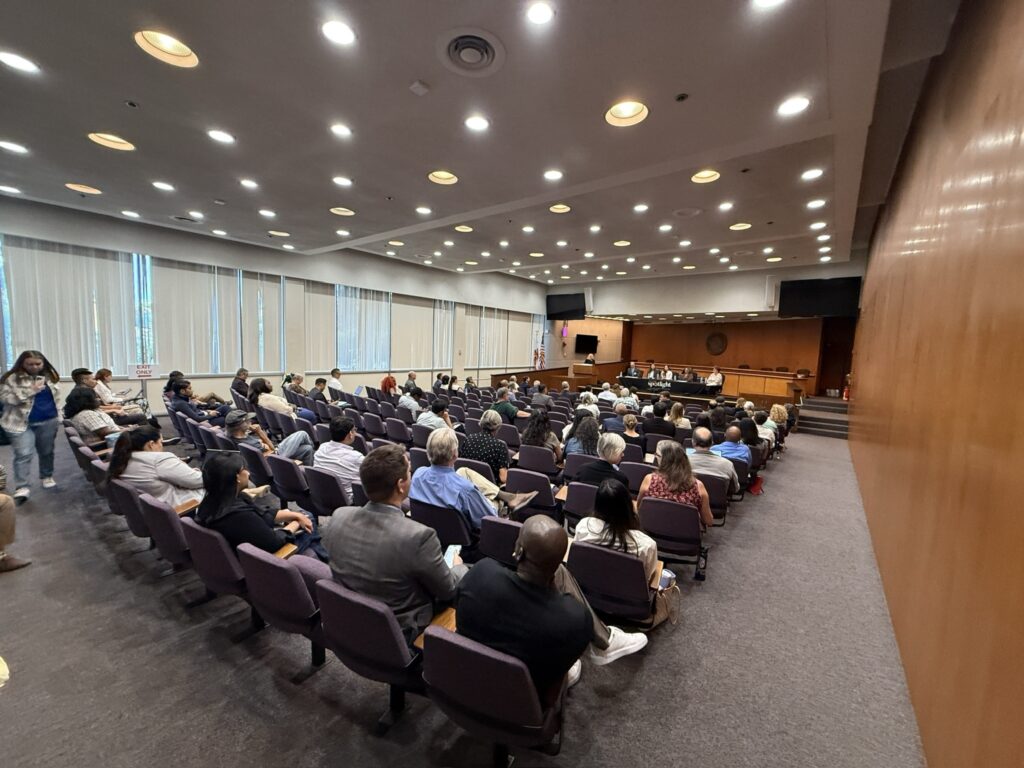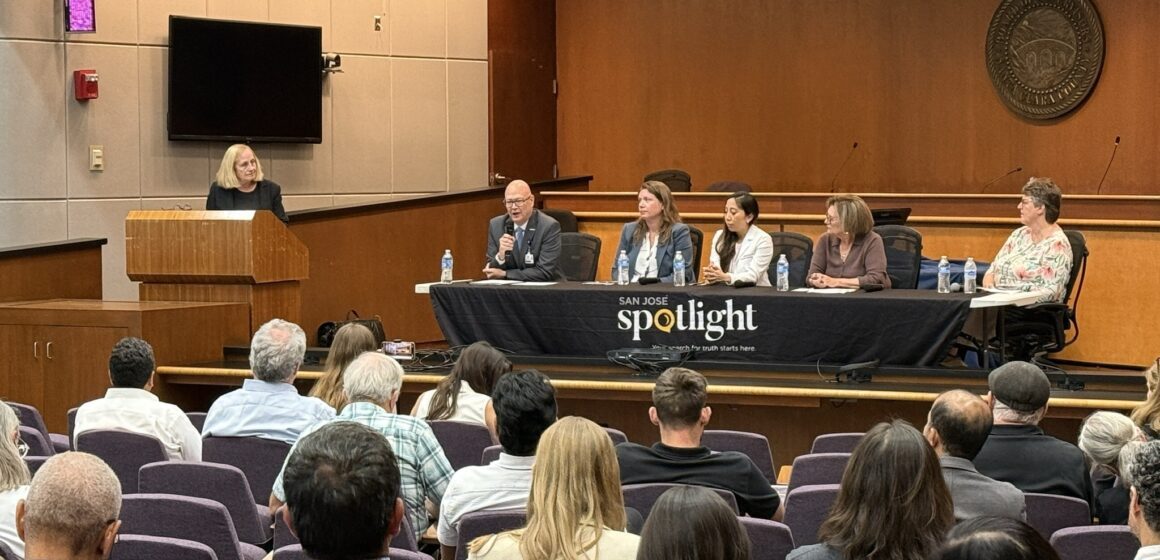Santa Clara County health care leaders weren’t shy about voicing what’s in store for the future of public health at a forum hosted by San José Spotlight, as they brace for billions in revenue cuts.
Editor Moryt Milo, who moderated the Sept. 17 State of Health Care in Silicon Valley event, questioned panelists on the ramifications of $1 billion in federal Medicaid revenue cuts slated to hit the county’s public health care system, and their plans to tackle an estimated total $4.4 billion revenue drop through fiscal year 2029-30. These cuts are the result of federal slashes under President Donald Trump’s watershed budget bill H.R. 1.
The panelists addressing the problem included Santa Clara Valley Healthcare CEO Paul Lorenz; Santa Clara County Behavioral Health Services Department Deputy Director Megan Wheelehan; Rachel Ruiz, Valley Physicians Group chair and pediatric gastroenterologist; Dolores Alvarado, Community Health Partnership CEO; and Pattie Beebe, a Santa Clara Valley Medical Center general staff developer and representative of the Registered Nurse Professionals Association.
Panelists said the legislation, also known as the One Big Beautiful Bill Act, will ravage the second biggest county-owned, public hospital system in the state, which encompasses four hospitals and 15 health clinics. Lorenz said the cuts will affect one in four residents who rely on Medicaid countywide, known as Medi-Cal in California.
The discussion comes as Santa Clara County is pushing Measure A as a partial stopgap for the impending cuts. The five-eighths cent sales tax increase will appear on the Nov. 4 special election ballot. It’s expected to generate $330 million annually. But that only covers a third of the anticipated cuts.
Lorenz oversees the county’s public hospital system and said even if Measure A passes, there will have to be cuts and reorganization to keep the hospital system afloat as it loses nearly a quarter of its $4.6 billion annual budget. He said that could lead to longer wait times in emergency rooms countywide, as patients who can’t afford medical attention without Medi-Cal are forced to let chronic conditions worsen.
“It will impact every resident in every hospital, and every provider that’s in our community,” he said at the forum. “This is truly devastating, and I don’t know that people will fully appreciate it until we’re actually in the tsunami. And by that time, it’s far too late.”
The cuts aren’t limited to physical health.
Wheelehan said the county Behavioral Health Services department’s biggest source of funding is Medi-Cal. About 80% of patients with insurance in the department, which treats mental disorders and substance use, rely on Medi-Cal to pay their medical bills.
The department has expanded in recent years to address the public health crisis declared by the Board of Supervisors in 2022. This month, the county opened a walk-in substance use recovery facility and the department plans to open a new psychiatric facility on the Santa Clara Valley Medical Center campus in early 2026. It will be the first inpatient facility in the county for children and teens, along with a separate, secure section for adults.
“I’m just super pained to think about taking a step backward from that (due to cuts), never mind slowing the work that we’ve already done,” Wheelehan said.
Panelists touched on collaboration as a critical strategy for getting through the impending cuts that could affect unique specialty programs. The public health system operates two of only three trauma centers and handles most trauma cases originating within the county. Its burn center is one of only three of its kind between Los Angeles and the Oregon border.

Beebe said collaboration is necessary not only to keep specialty departments above water, but also to treat patients daily. She’s worried quality staff will leave if they’re overworked and underpaid after they complete training and the cuts hit, and how patients will be affected.
“If you end up in the position of denying somebody care, that’s a really bad spot to be in,” Beebe said. “I’m ethically against that, and I’m professionally against that. When you see somebody that is sick and hurting and you have the ability to help them, you do. And to not do that is my worst nightmare.”
Alvarado, whose nonprofit focuses on community-based health centers and clinics, said health care professionals have to prioritize the most vulnerable residents relying on the system. That could mean seeking state support, since Medi-Cal is a state-run program.
“We are hitting a very specific population with 12 or 13 arrows all at once,” Alvarado said. “It’s unthinkable what’s going on here.”
Ruiz said the health care system needs to be more cost efficient, such as having patients receive their vaccines at a pharmacy rather than the hospital. She said hospitals get reimbursed for vaccines at pharmacies, but they cost thousands of dollars at hospitals.
“We will not get through this unless we come together as a community, wearing all of our different hats,” she said.
 While the conversation was dominated by the frightening loss of revenue, Lorenz said the county remained steadfast on following through with its promise to restore services to Regional Medical Center, which it purchased last year from former for-profit owner HCA Heathcare. Officials plan to restore labor and delivery care around Oct. 20. They already restored the hospital’s trauma center to a Level 2 rating after HCA downgraded it to a Level 3 in April.
While the conversation was dominated by the frightening loss of revenue, Lorenz said the county remained steadfast on following through with its promise to restore services to Regional Medical Center, which it purchased last year from former for-profit owner HCA Heathcare. Officials plan to restore labor and delivery care around Oct. 20. They already restored the hospital’s trauma center to a Level 2 rating after HCA downgraded it to a Level 3 in April.
“We’re working very closely with our physicians, nurses and community (to make it happen),” Lorenz said, referring to the obstetrics unit. “We’re looking forward to doing that.”
Lorenz added the health care system needs all the help it can get to ensure hospitals continue to provide necessary care in the future.
“Without the tax measure, without the state support, we are left with a $1 billion hole in our budget and we are going to have to make difficult decisions,” he said. “So any amount of funding that we can get in support for the community will make a difference in our ability to maintain critical and special services for our community.”
Contact Annalise Freimarck at [email protected] or follow @annalise_ellen on X.



Leave a Reply
You must be logged in to post a comment.